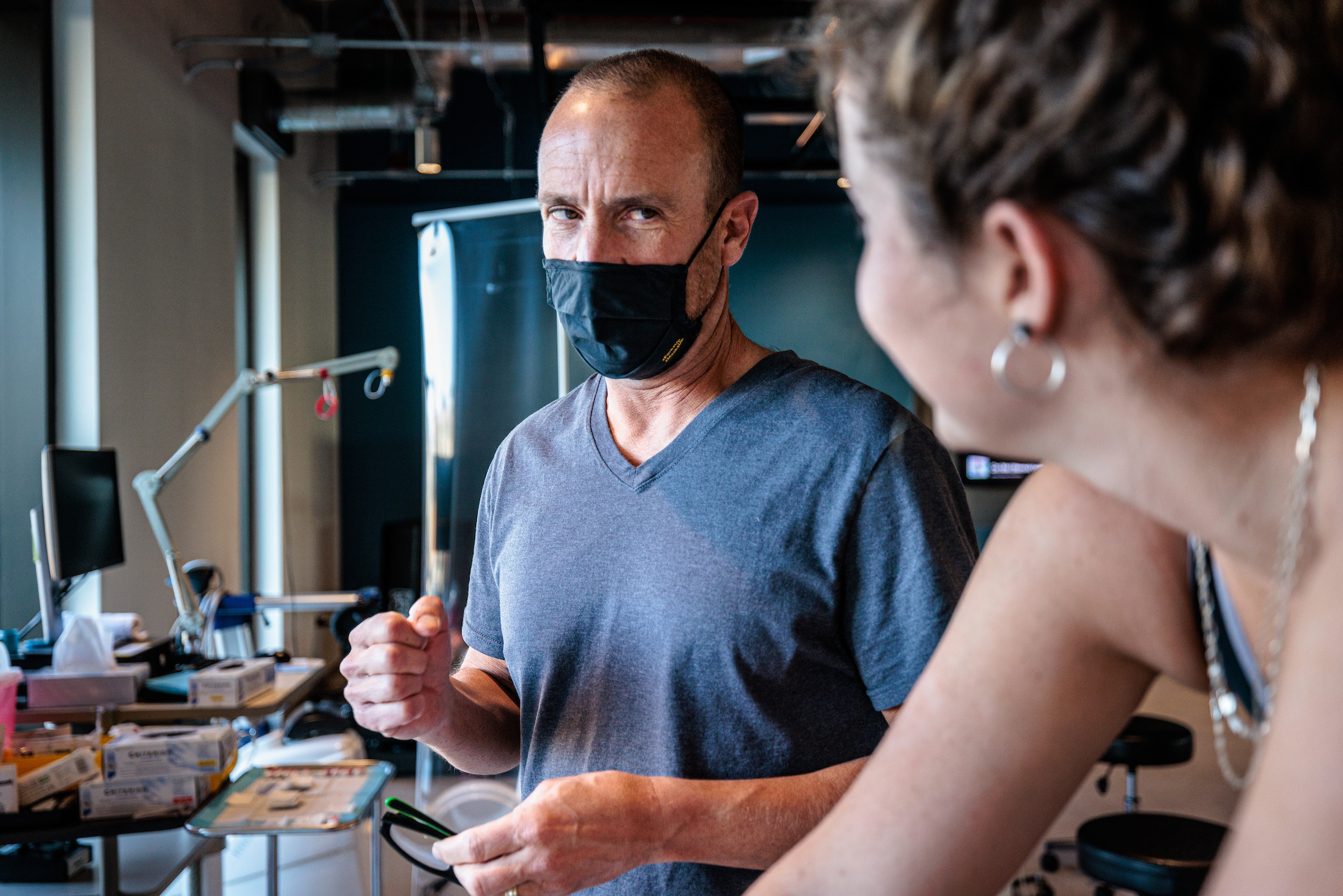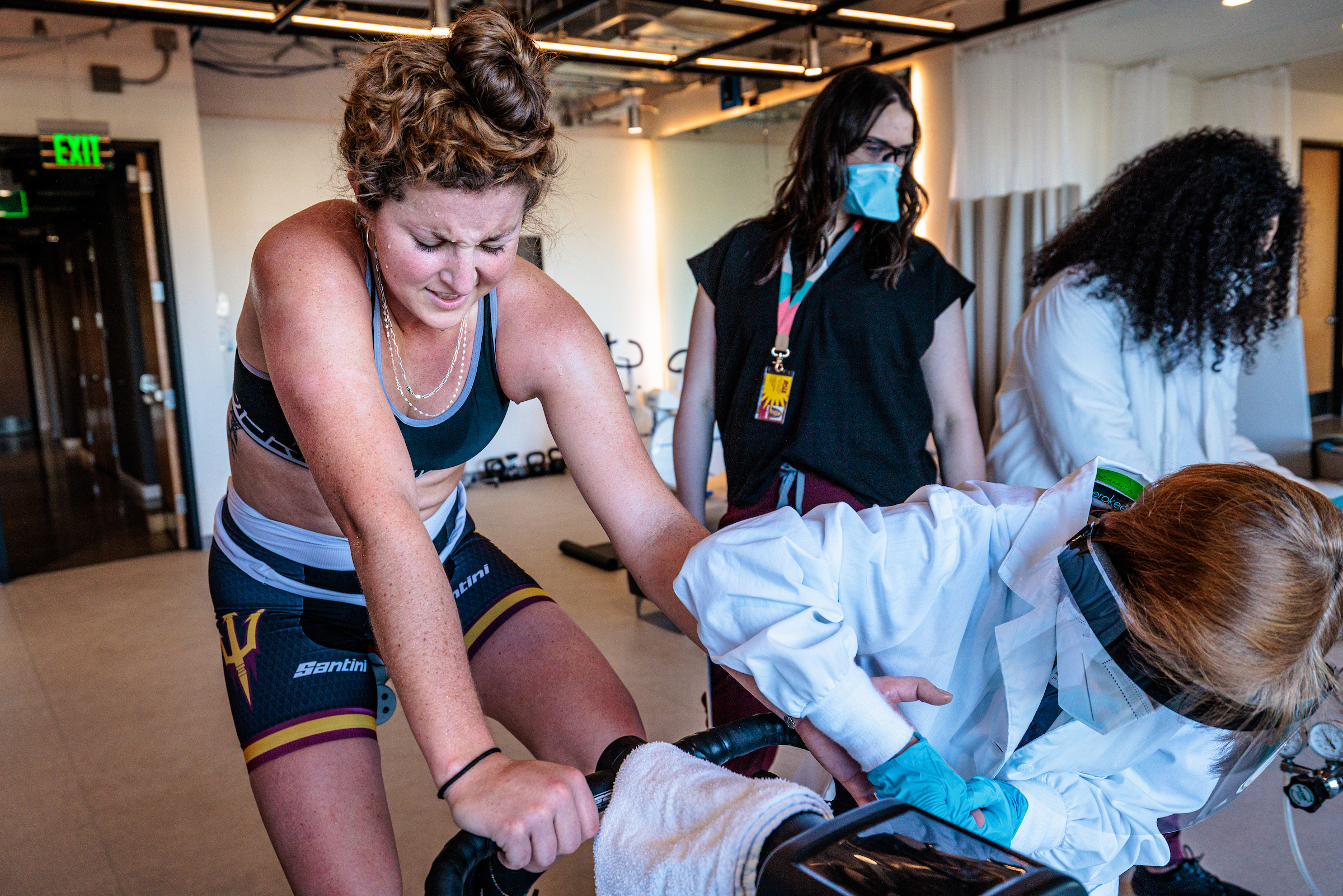Work smarter, not harder: The ASU triathlon team is using science to do just that, and Arizona State University’s newest biomedical facility in downtown Phoenix is playing a part.
ASU’s Translational Research Center at 850 PBC — part of the Phoenix Biomedical Campus — was the site of recent intensity training and lactate-threshold testing for the athletes, conducted by College of Health Solutions staff and students.
Clinical Research Project Manager Theresa Jorgensen said the 850 PBC facility, which opened last spring, has been an asset to the community while also supporting research.
“This new building has really connected us more directly to the people and the populations that a lot of our research surrounds,” Jorgensen said. “The accommodations of being able to handle multiple protocols and a higher volume has been essential to support our research.”
College of Health Solutions Associate Professor Jason Siegler encourages ASU triathlete Kira Stanley as she undergoes a lactate threshold test Feb. 2 at the Translational Research Center at 850 PBC in downtown Phoenix. Head coach Cliff English has his perennial national champion athletes undergo the testing to quantify the intensity of exercise at which lactate begins to accumulate in the blood faster than it can be removed. He customizes each athlete’s training with the data to optimize her performance. Photo by Charlie Leight/ASU News
When someone exercises at a high intensity, a substance called lactate is created that allows glucose breakdown, and therefore energy production, to continue. After several minutes of such anaerobic activity, however, lactate accumulates in the blood faster than it can be removed — a point called the lactate threshold, which is associated with fatigue.
The testing helps the team to better pinpoint each individual’s threshold and optimize their training plan. Staying below that threshold allows an athlete to perform better and more efficiently.
“These tests give you a lot of great data about heart rates,” said Cliff English, head coach of the women’s triathlon team. “It allows us as coaches to know exactly the workload that we are looking at what is happening internally with our bodies as well as pinpoint areas to possibly develop further in some of these athletes as well.”
The threshold training — the first the team has done since 2019 because of the pandemic — also allows the athletes to better monitor what’s happening.
“You get a good feel for what's going on in your body,” English said. “You can kind of tell when you’re starting to get a little bit of lactic acid, so then you kind of know you’re at that lactate threshold. It also reminds you to pace yourself.”
Phlebotomist Margarita Telles de Stirk takes a blood sample from ASU women’s triathlon team captain Kira Stanley as she hits her lactate threshold Feb. 2. Stanley is a fourth-year marketing and sports business student. Photo by Charlie Leight/ASU News
Kira Stanley, member of the triathlon team and a fourth-year marketing and sports business student, says the test results are utilized to find their zones for racing.
“When an athlete finds their zone, they can optimize how they train to get specific watts and heart rates to train more intelligently,” Stanley said. “We will have specific target watts or heart rates to hit while we are training so we know exactly how hard to go.”
An individual’s lactate threshold can be raised by increasing weekly running routines, varying tempo during runs and utilizing interval training. College of Health Solutions Associate Professor Jason Siegler said the triathlon team will have continued access to the 850 PBC facility for further monitoring as the team adjusts workout routines.
“We’re working towards long-term collaborative efforts here to keep them consistently coming in, because there’s a lot of merit in tracking a lot of their athletes over time,” Siegler said. “… from the time they come in as freshmen to the time they leave as a senior.”
ASU student reporter Rudy Aguado contributed to this article.
Top photo: Exercise and nutrition doctoral student Shannon Wilson (right) asks ASU women’s triathlon team captain Kira Stanley about her perceived effort as she undergoes a lactate threshold test at the Translational Research Center lab at the 850 PBC building Feb. 2 in downtown Phoenix. Photo by Charlie Leight/ASU News
More Science and technology

ASU and Deca Technologies selected to lead $100M SHIELD USA project to strengthen U.S. semiconductor packaging capabilities
The National Institute of Standards and Technology — part of the U.S. Department of Commerce — announced today that it plans to award as much as $100 million to Arizona State University and Deca…

From food crops to cancer clinics: Lessons in extermination resistance
Just as crop-devouring insects evolve to resist pesticides, cancer cells can increase their lethality by developing resistance to treatment. In fact, most deaths from cancer are caused by the…

ASU professor wins NIH Director’s New Innovator Award for research linking gene function to brain structure
Life experiences alter us in many ways, including how we act and our mental and physical health. What we go through can even change how our genes work, how the instructions coded into our DNA are…


